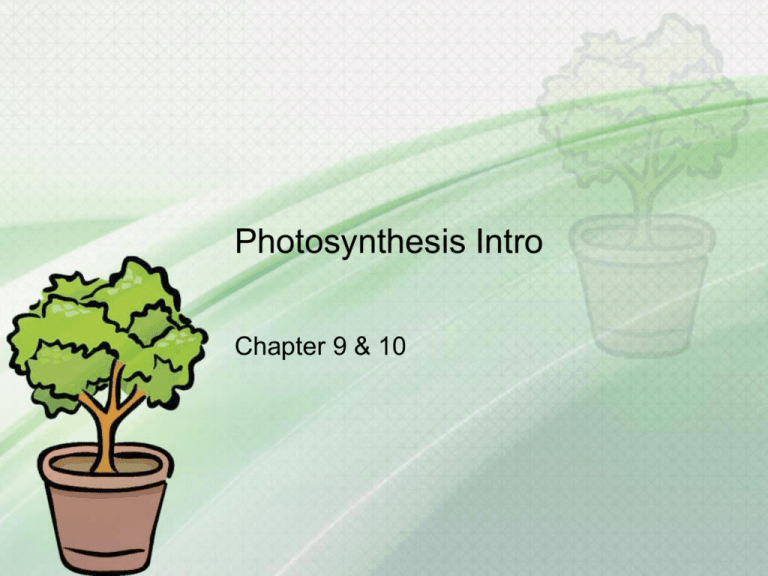Cell Energy
advertisement

Photosynthesis Intro Chapter 9 & 10 What you need to know! • How chemiosmosis generates ATP in the light reactions • How photosystems convert solar energy into chemical energy Physics of Light • Light, like all radiation, has energy • Radiation can be sorted into an electromagnetic wave spectrum according to its wavelength • Visible light can be broken up into: red, orange, yellow, green, blue, indigo, violet Colored Solid Objects • The color of solid objects is a result of absorbing and reflecting parts of the visible light spectrum • Example: Green object – Reflects green – Absorbs: red, orange, yellow, blue, purple – Absorbance spectrum of plants • Reflected light is useless to plants. Plants cannot grow under green light – It has the same affect as total darkness Structure of a Chloroplast • Chloroplasts have a double membrane (endosymbiotic theory) • Inner membrane builds thylakoids: hollow membrane compartments that form stacks called grana. Thylakoid Membrane • Molecules embedded in the phospholipid bilayer of the thylakoid membrane: 1. ATPase • Thylakoid space is used for H+ gradient and ATP synthase in the membrane 2. Pigments • Chlorophyll a, b, carotenoids, and xantophylls are the main pigments serving photosynthesis are embedded in the membrane 3. Electron transport chain molecules: • Ubiquinones, and cytochromes are embedded in the membrane Structure of Cholorophyll Structure of Chlorophyll • Magnesium Porphyrine Ring • Chlorophyll is a molecule that contains nitrogen (present in fertilizer, decaying compost, and proteins) or has to bound out of the air’s N2 (by nitrobacteria) • Expensive molecule: is recycled in fall in temperate climates • Chlorophyll has a hydrocarbon tail to make it lipophilic for membrane attachment Structure of Cholorophyll • Chlorophyll exists in two different versions: chlorophyll a and b. Absorbance spectrums for both pigments maximize absorbance in the red and blue range Leaf Structure and Photosynthesis • Photosynthesis takes place in the mesophyll of a plant’s leaf. • Gas exchange will take place through the stomata, during photosynthesis, stomata need to be open. Plants inevitably transpire through open stomata, which also helps to keep plants cool, but: • Only turgid stomata cells are open; if they become flaccid, they close, and photosynthesis stops. Leaf Structure and Photosynthesis Cuticle Mesophyll Vein Stomata Paper Chromatography • • • Technique for separating and identifying pigments from cell extracts. The solvent moves up chromatography paper by capillary action Pigments (solutes) are dissolved in the solvent and are carried up the paper Paper Chromatography • Differing pigments have different properties: – Solubility, size/shape, polarity • Different bands form as the solutes separate while they migrate up the paper Rf Values of Pigments • Rf is a ratio of the migration of the pigment (B) over the migration of the solvent (F) • Rf = B/F • B = distance (mm) from the bottom of the pigment origin to the bottom of the pigment migration • If more than one pigment molecule is tested the highest band is B1, the next band is B2, etc. • F = distance from the bottom of the pigment origin to the bottom of the solvent front Solvent Front Rf Values of Pigments B4 Band # Distance migrated Rf value Identification of substance 1 2 • Rf values of substances are specific to the chromatography B3 system used. If paper or solvent is changed, Rf values B2 change • Rf values do not change with migration length in a system B1 • Rf values are always between 0&1 Pigment Origin








